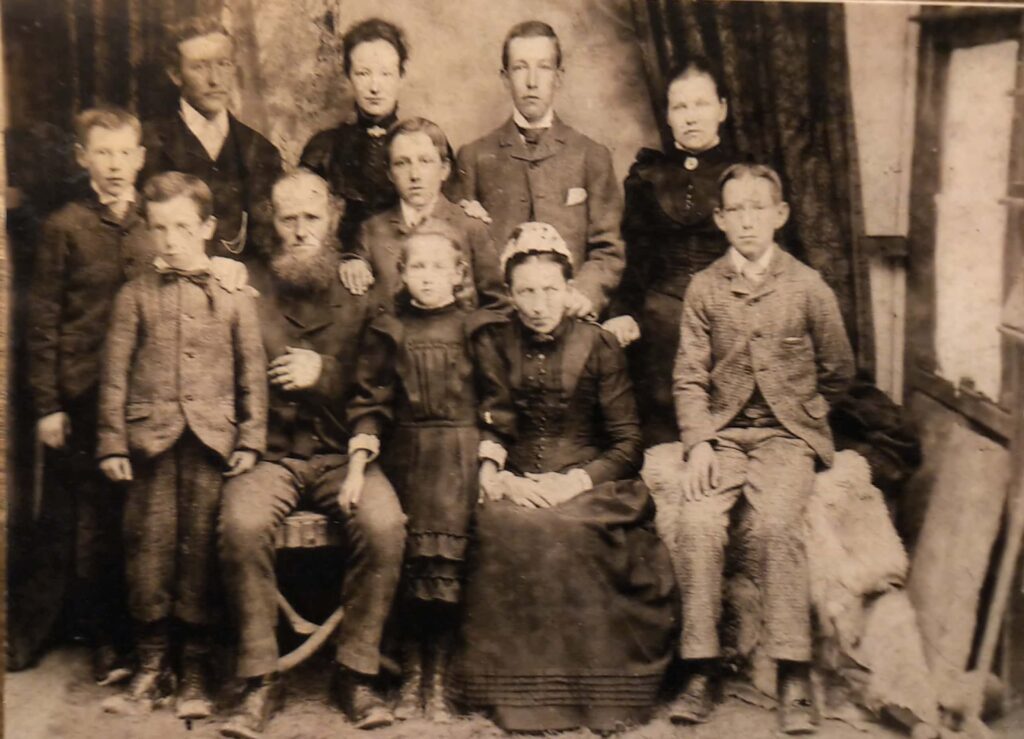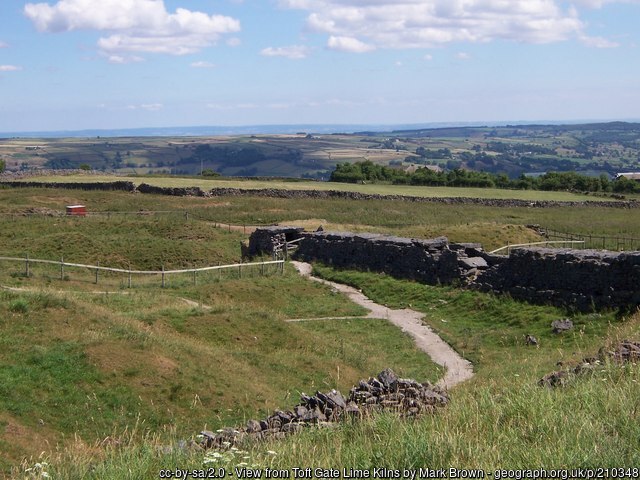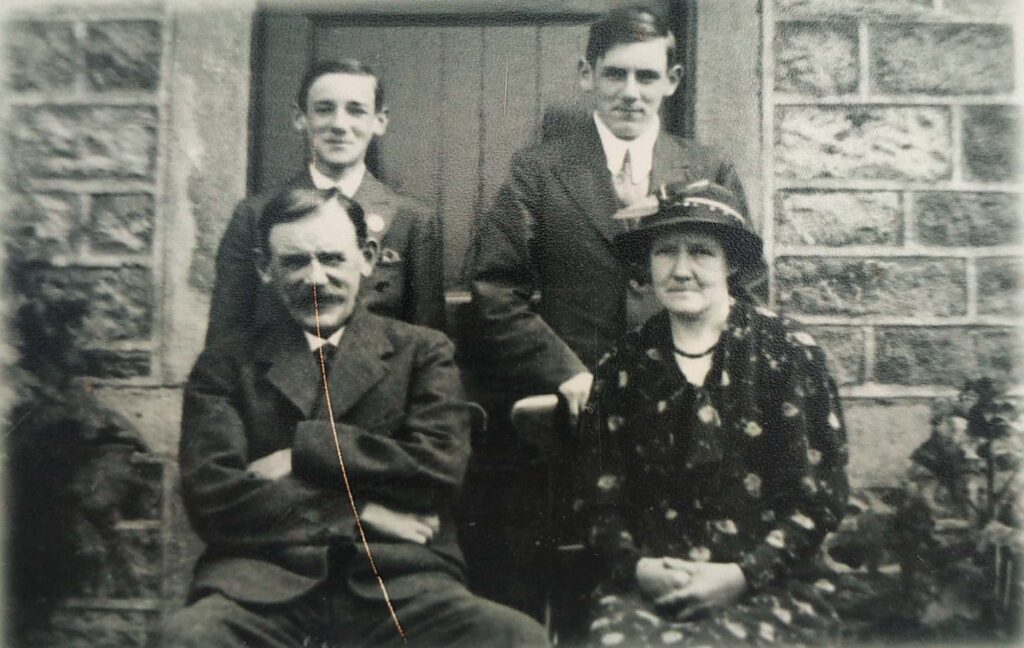
Back row L to R: Thomas, Margaret, Walker, Elizabeth. Middle row L to R: David, Major, Front row L to R: Benjamin, Richard (father), Mary, Mary (mother), Richard
This is a story of a family (the Wellocks), their home (Toft Gate on the edge of Greenhow Hill near Pateley Bridge in Yorkshire) and the impact of a little studied economic era on one family’s lives (The Great Depression of British Agriculture).
Before we journey to Yorkshire & study the economics lets meet the family.
Mary (nee Walker) and Richard Wellock were my great, great grandparents. Here they are in my Mum’s favourite ancestor photo taken c. 1893 surrounded by their nine surviving children. My great grandmother, Mary, is the young girl in the middle of the photo with her hands on the legs of her parents. My great, great grandparents, Mary & Richard, look particularly stern and careworn. Their children, clearly in their best clothing, show no hint of a smile.
To understand this photo and learn more about the family we first need to know more about Toft Gate and the Great Agricultural Depression.

Toft Gate is one of those solid old stone Yorkshire Dales farmhouses that is still farmed to this day. You might visit the barn café on a beautiful spring day and idly ponder how wonderful it might be to live there. Until winter kicks in. At 1,300 feet above sea level, Greenhow Hill is “probably” the highest village in Yorkshire. Winters are cold and long with wind rattling over the moor. Work was hard with a fairly straight choice between farming and lead mining. Rudyard Kipling describes it thus:
“Greenhow Hill stands up ower Pately Brig. I reckon you’ve never heeard tell o’ Green-how Hill, but yon bit o’ bare stuff if there was nobbut a white road windin’ is like ut; strangely like. Moors an’ moors an’ moors, wi’ never a tree for shelter, an’ gray houses wi’ flagstone rooves, and pewits cryin’, an’ a windhover goin’ to and fro just like these kites. And cold! A wind that cuts you like a knife. You could tell Green-how Hill folk by the red-apple colour o’ their cheeks an’ nose tips, and their blue eyes, driven into pin-points by the wind. Miners mostly, burrowin’ for lead i’ th’ hillsides, followin’ the trail of th’ ore vein same as a field-rat”.
By then Greenhow Hill was in economic decline. In part this was area specific. The mines, which had been in operation since Roman times, were now deep below the water table, making them far more expensive than newer large open pit operations abroad. One by one between the 1850s and 1890s the mines closed. Some miners shifted to farming, many moved away.
The Great Depression of British Agriculture was much more widespread. Generally dated from 1873 to 1896 it impacted farmers across Britain. The great prairies in the US & Canada were being opened up. The rise in steamships made transportation of grain, meat, butter and cheese far cheaper, resulting in significant falls in price back in Britain. By 1894 – 1895, prices had reached their lowest levels in 150 years. The arable farms serving Britain’s largest cities suffered the most but it can’t have been without impact on Toft Gate.
Now we can come back to our Wellock family in the photo.
Richard Wellock was born on 7 April 1844 at Halton Gill. He married Mary Walker (b. 17 April 1845 at Capon Hall, Malham Moor) on 29 May 1866 at St Michaels Church, Linton in Craven. At the time he was working as a farm servant in Bordley. Halton Gill, Malham Moor, Linton-in-Craven and Bordley may all be within twenty miles of each other but they are long distances to walk. Richard & Mary probably only met because Toft Gate produced insufficient income for father and son forcing Richard to look elsewhere for work.
Eleven children rapidly followed: Thomas (b. 1866), Richard (b. 1867), Elizabeth (b. 1870), Margaret (b. 1872), Walker (b. 1874), Richard (b. 1877), David (b. 1879), Major Preston (b. 1882), Benjamin (b. 1884), Mary, my great grandmother (b. 1886) and Hornby (b. 1888).
The first three children were born in Bewerley, Ripon & Litton. By 1871 the family were back with Thomas & Isabella at Toft Gate but described as “staying for a few weeks.” It is likely that Richard had been a farm worker over this time, striving to find either a long term position or his own farm to lease. Then a period of stability. The family moved into Hole Bottom, and then Blazefield both on Hardcastle Moor just a couple of miles away from Toft Gate. Richard was farming at Toft Gate again with his father.
Thomas died on 28 January 1885 and his estate passed to his wife, Isabella. Probate was described as excluding leaseholds and I am curious as to whether this was deliberate. In my family experience, leases were passed from father to son. Yet this was an age of agricultural depression where landlords were desperate for tenants. Whatever the circumstances, Richard, Mary and their family once again moved back into Toft Gate. At the age of 41 Richard finally held the lease of a farm.
Life wasn’t easy – we can see that from the photo in the clothing and the faces of a couple who weren’t yet 50. This is also, more importantly, a photo of a family in mourning. Hornby, the youngest child, succumbed to scarlatina/ scarlet fever in June 1893. Richard & Mary must have gathered the children together seeking a permanent record in case others, too, were lost.
I prefer, however, to see this photo as reflecting the closeness of a family and the start of a dynasty. Each of the remaining nine children lived long lives, reaching an average age of 74. All nine married and seven have surviving descendants, with a surprising frequency of Hornbys amongst them. The continued agricultural depression encouraged David & Major to emigrate to Canada where they rapidly settled in Saskatchewan. The family remained close, with both letters and people crossing the Atlantic for many years. (You can read more on the relationship between the siblings through Mary’s birthday book & a road trip to Estevan)
Mary (my great grandmother and the youngest child in the original photo) married George Thomas Barrett in 1917. They had two children, Henry Wellock Barrett (b. 1918) & Richard Walker Barrett, my Grandpy, (b. 1921) playing tribute to both of Mary’s parents. And later, in 1927, with Richard’s health failing and Mary (mother) having died, Mary & George moved back to Toft Gate. Richard died in 1931 and the family connection with Toft Gate ended when Mary, George & family moved out in 1934 bringing us to the end of this story.

With much gratitude to Mary & Richard Wellock who, in grief, brought their family together for this photo, to the Greenhow Hill local history group who’s book “Life on the Hill” added a lot of colour to this blog and also to Amy Johnson Crow whose 52 ancestors in 52 weeks encouraged me to publish this story.
